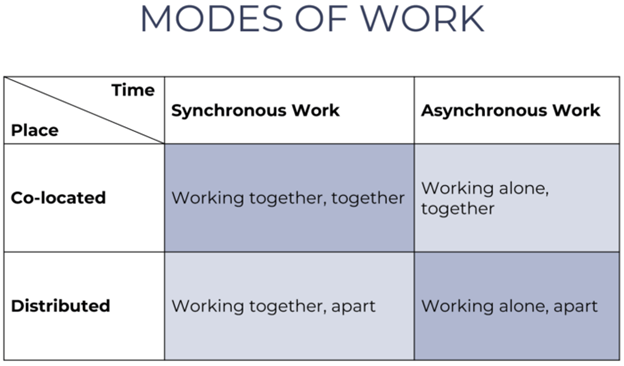PART II — Building Cohesive Teams in a Hybrid Environment
By Valentina Kibedi, Director of Learning Services, Laridae
This is Part II of a two-part series on hybrid team cohesion. Part I appeared in the September 2022 edition of CSAE’s publication.
In Part I, we explored the notion that hybrid may not, in fact, be entirely responsible for a lack of cohesion in work teams in organizations today.
We asked whether the change to hybrid has simply shone a spotlight on previously existing weaknesses in management, culture, or organizational process – the same way any other change might impact the status quo.
We accepted that hybrid is making things feel harder than before, but that the benefits this workstyle offers individuals will pay off in the long run. We just need to improve or adapt our skills to accommodate the differences.
Considering that hybrid is not new and that teams have been successful with this model long before 2020, what can we learn from them? What do effective hybrid teams have in common?
Shared purpose
Fundamentally, cohesive hybrid teams unite around a shared purpose, such as an organization’s mission, and strategic or operational plan. No matter where they are, this is their collective North Star.
Knowing this should come as a relief to association leaders. It should not be difficult for them to build tactics to reflect on or celebrate achievements toward this shared purpose in group and 1:1 settings.
Effective teams also know how to answer three foundational questions of organizational culture:
- Who are we?
- Why are we here?
- How do we get it done?
If your organization lacks these cornerstone elements of being, don’t despair. At Laridae, the consulting and training company where I work, we help leaders through mission, vision, and values exercises, and draw up strategic and operational plans every day. No matter your approach, do ensure this work gets done.
Awareness of the where — and when, of hybrid work
Effective hybrid organizations are considerate of both time and place when thinking about successful ways of working together. Consider the following:

Synchronous Work means it’s happening at the same time. Everyone puts in a 9-5 shift, or similar. Synchronous work can be co-located (altogether in one place) or distributed (different places).
Asynchronous Work happens at different times. People work different shifts at the office (co-located), or perhaps they work 8 hours over a 12-hour period to accommodate school pickups or senior care while operating remotely (distributed).
The point of knowing these terms is to understand that one-size-fits-all policies can no longer apply to workplace planning. We must challenge assumptions about the scenarios in which people will receive messaging, or the environment or time at which someone may be doing their work.
We must commit to thinking deeply about how work happens across these two axes. This means challenging previously held assumptions and intentionally designing hybrid arrangements that work best for specific circumstances.
Effective communications
Cohesive hybrid teams have established internal communications practices that are clearly understood and followed.
For example, thinking about the four modes of work from above, successful teams have prioritized what work needs to be synchronous and what can be asynchronous.
Synchronous work would include meetings for in-depth discussion or debate, or which involve higher-stakes decisions; 1:1s, coaching & feedback & mentoring, project kick-off meetings, some onboarding activities, and some team building activities. We’re asking our clients to set a high bar for synchronous work. In a hybrid environment, asking everybody to come together needs to be reserved for the right things.
Asynchronous work is no less important. It’s important to identify what can be done asynchronously, and where this would, could or should happen. Asynchronous work tends to include ongoing status updates, straightforward questions and information sharing, and individual-focused work.
Successful hybrid teams have been trained around the use of the right technology or communications channel for the right work style. For example, synchronous work requires video meetings and phone calls. Asynchronous work takes place on group messaging channels and email.
Where information is shared is also important to hybrid teams. Standardizing channels and mediums and communicating expectations around what goes where can help create a level playing field. Hybrid teams must be intentional about information sharing to ensure everyone has access to the same knowledge. Hallway conversations, or ‘walk and talk’ discussions create inequity, wherein some team members are ‘in the know’ and others are not.
Keeping workflow conversations on collaboration platforms like Slack or Teams is a terrific way to create a searchable, transparent flow of information. Knowledge management systems such as Guru can help organizations build a repository of institutional knowledge accessible to everyone.
Hybrid teams should default to public communications channels whenever possible to ensure the flow of information remains open, accessible, and searchable to everyone. Note that notifications management is helpful for those who feel bombarded with platforms like Slack.
Using the right systems can assist with feelings of fragmentation and eroded trust that comes from feeling left out, or legitimately being left out of the loop on important decisions or details.
Intentional relationship-building
Effective hybrid teams design and schedule relationship practices and team connection opportunities. Association leaders and managers must be thoughtful about their relationship practices; lack of intention can exacerbate proximity bias and create exclusion and inequity.
Effective hybrid teams also treat team building and team cohesion development time as seriously as they do “real work”. This means making team culture, social connection, bonding, and inclusion efforts as important as other business.
How do you do this? You build it right into your success metrics. You get buy-in and support from leadership. You declare champions within the organization to implement and push things forward. However, as noted before, if the leadership level doesn’t adopt this as a priority, it’s not going to be sustained, and teams will struggle to build cohesion long-term.
Anticipate and navigate cohesion roadblocks
Successful hybrid teams ensure equity in participation and work to identify and address behaviours or practices getting in the way of cohesion, such as lack of policies that create respect and safety; proximity bias; erosion of trust.
This means taking care to ensure everyone feels (and is) included and that policies and practices are frequently being considered to ensure respect, safety, and equitable practices. It means ensuring opportunities for development and support, such as coaching and mentoring, are offered to everyone regardless of location, identity, or work arrangement.
I encourage you to share these ideas with your team, and in doing so, open a conversation that will reignite the commitment to creating a strong, cohesive culture.
Valentina Kibedi is the Director of Learning Services at Laridae, a management consulting and training firm that works exclusively with non-profit organizations and associations across Canada. Laridae partners with non-profit leaders, teams, and communities to find clarity, build capacity, and empower meaningful change.
Previously published on the Laridae blog

